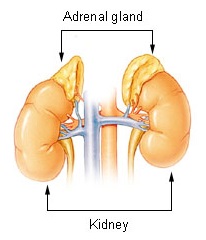Source: Pr Anne-Paule GIMENEZ-ROQUEPLO MD; Pr Pierre-François PLOUIN MD. Orphanet
Catecholamine-producing tumors may arise in the adrenal gland
(pheochromocytomas) or in extraadrenal chromaffin cells (secreting
paragangliomas).
Catecholamines are hormones made by the adrenal glands. These glands are
on top of the kidneys. Catecholamines are released into the blood when a
person is under physical or emotional stress. The main catecholamines
are dopamine, norepinephrine, and epinephrine (which used to be called
adrenalin).
Their frequency is about 0.1% in patients with
hypertension and 4% in patients with a fortuitously discovered adrenal
mass.
An increase in the production of catecholamines causes symptoms
(mainly headaches, palpitations and excess sweating) and signs (mainly
hypertension, weight loss and diabetes) reflecting the effects of
epinephrine and norepinephrine on alpha and beta-adrenergic receptors.
Catecholamine-producing tumors mimic paroxysmal conditions with
hypertension and/or cardiac rhythm disorders, including panic attacks,
in which sympathetic activation linked to anxiety reproduces the same
signs and symptoms.
These tumors may be sporadic or part of any of
several genetic diseases: familial pheochromocytoma-paraganglioma
syndromes, multiple endocrine neoplasia type 2, neurofibromatosis type 1
and von Hippel-Lindau disease.
Familial cases are
diagnosed earlier and are more frequently bilateral and recurring than
sporadic cases.
The most specific and sensitive diagnostic test for the
tumor is the determination of plasma or urinary metanephrines.
The tumor
can be located by computed tomography, magnetic resonance imaging and
metaiodobenzylguanidine (MIBG) scintigraphy.
Treatment requires resection of
the tumor, generally by laparoscopic surgery.
About 10% of tumors are
malignant either at first operation or during follow-up, malignancy
being diagnosed by the presence of lymph node, visceral or bone
metastases.
Recurrences and malignancy are more frequent in cases with
large or extraadrenal tumors.
Patients, especially those with familial
or extraadrenal tumors, should be followed-up indefinitely.
